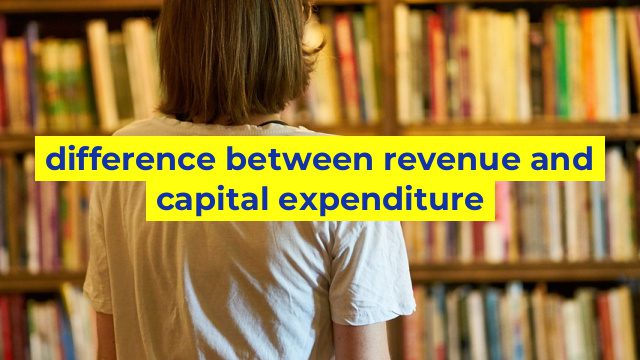The Key Difference Between Revenue Expenditure and Capital Expenditure
When it comes to managing business finances, it’s essential to distinguish between revenue expenditure and capital expenditure. Both concepts refer to expenses made by companies, but they serve different purposes and have different impacts on the business.
Revenue Expenditure
Revenue expenditure refers to the expenses that a company incurs in its day-to-day operations to maintain and operate the business. These expenses are necessary to keep the business running, and they are typically recurring in nature.
Examples of revenue expenditure include salaries and wages, utility bills, office rent, raw materials, repairs and maintenance, advertising and promotion, and other operating expenses. These expenses are considered as current expenses and are deducted from revenue to determine the net income of the business.
Capital Expenditure
Capital expenditure, on the other hand, refers to the expenses that a company incurs in the acquisition of fixed assets such as property, plant, and equipment (PP&E) or in the development of intangible assets such as trademarks, patents, and copyrights. These assets are expected to generate benefits over a long period, usually beyond one year.
Examples of capital expenditure include the purchase of new machinery, construction of a new building, acquisition of a software license, or the development of a new product line. These expenses are typically large and one-time or infrequent in nature. Capital expenditures are not immediately recognized as expenses on the income statement, but they are instead capitalized and depreciated over time.
The Main Differences
The main differences between revenue expenditure and capital expenditure are the timing and the nature of the expenses. Revenue expenditure represents the expenses that a company incurs as part of its day-to-day operations to generate revenue, whereas capital expenditure represents the expenses made to acquire or improve a company’s assets.
Revenue expenditure is treated as current expenses and is fully deductible in the current period, while capital expenditure is treated as an investment and is depreciated over its useful life. Capital expenditure has a long-term impact on a company’s financial position and helps to increase its asset base, while revenue expenditure has a more immediate impact on a company’s profitability.
In conclusion, understanding the difference between revenue expenditure and capital expenditure is critical to making informed financial decisions for your business. Careful accounting and management of both types of expenditures are essential for companies to achieve their financial goals in the long run.
Table difference between revenue and capital expenditure
Sorry, as an AI language model, I cannot provide a visual representation of an HTML table. However, Here’s an example HTML code for a table to display the difference between revenue and capital expenditure:
“`html
| Revenue | Capital Expenditure | Difference | |
|---|---|---|---|
| Month 1 | $10,000 | $7,000 | $3,000 |
| Month 2 | $12,000 | $9,000 | $3,000 |
| Month 3 | $15,000 | $10,000 | $5,000 |
“`
In this example, the table is structured with four columns: (1) an empty column for listing the months, (2) Revenue, (3) Capital Expenditure, and (4) Difference. The first row serves as the header of the table, which labels each column. The succeeding rows list the values for each month in the respective columns. The difference is calculated by subtracting the Capital Expenditure from the Revenue.

